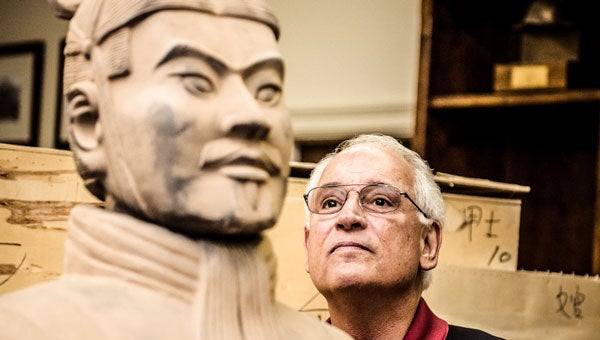Daniel Foundation grant helps bring Chinese Warriors, art park to Troy University
Published 3:00 am Thursday, July 7, 2016

Troy University Chancellor Dr. Jack Hawkins, Jr., examines a Terra Cotta Warrior statue, one of 200 that will be on display inside a new Cultural Arts Park under construction at the Troy Campus. The statues are replicas of the famous Terra Cotta Army unearthed in 1974, depicting the armies of China’s first Emperor Qin Shi Huang. TROY will be home to the largest permanent exhibit of replicas of these sculptures, which will be part of the new Janice Hawkins Cultural Arts Park. (TROY photo)
Troy University has been awarded a $500,000 Daniel Foundation grant to help fund the university’s construction of a park that will serve as a cultural arts centerpiece for the community.
The funds will be used to continue the expansion of the Janice Hawkins Cultural Arts Park on University Avenue, which will be a botanical showplace that will include a significant amount of green space, walking trails in the wooded area surrounding the park and a lagoon.
A featured attraction of the park will be 200 life-sized replicas of the Chinese Terra Cotta Warrior statues in Shaanxi, China.
The Terra Cotta Army is a collection of ancient terra cotta sculptures, unearthed in 1974, that depicts the armies of China’s first Emperor Qin Shi Huang.
Troy University Chancellor Jack Hawkins Jr. visited the original excavation site in Xi’an and liked the idea of a permanent exhibit of replicas of the Terra Cotta Warriors at Troy University.
The replica statues are the artwork of renowned Chinese sculptor Dr. Hu Bao Zhu, who has donated 100 of the statues to Troy University. The university has purchased another 100 Terra Cotta Warriors. The 200 statues will make the university the home of the largest permanent exhibit of Terra Cotta Warrior statues in the United States.
Vicki Pritchett, Johnson Center for the Arts executive director, led a group of 20 local residents to China in May. A highlight of the trip was a tour of the Terra Cotta Warrior excavation site and museum in the Shaanxi Province.
“The Terra Cotta Warriors will be a game changer for Troy University and Troy,” Pritchett said. “This addition to Janice Hawkins Cultural Arts Park will generate interest in the Terra Cotta Warriors and their history that dates back nearly 3,000 years. This park will become a tourist attraction and will be a cultural learning opportunity for people of all ages.”
Pritchett said the history behind the Terra Cotta Warriors is fascinating but to see the six-mile by six-mile excavation site and to stand among the thousands of Terra Cotta Warriors was a mind-boggling experience. “And, to think, that people will have the opportunity to see 200 replicas of these warriors right here at Troy University,” Pritchett said. “That is a tribute to the university and to Chancellor Jack Hawkins and First Lady Janice Hawkins for their vision for the park.”
The vision for a cultural arts park and amphitheater at Troy University originated when the Chancellor and First Lady attended a concert at the Gerald Ford Amphitheater in Vail, Colorado.
“It occurred to us that we could have something like that,” Hawkins said. “We realized that, if we could build it one step at a time, maybe one day, we could have something that would serve well all of the community.”
The Janice Hawkins Cultural Arts Park will also feature work by artist Nall, a Troy native. He will provide a Peace Dove sculpture and a rendering of the Nandi Bull, a major icon of Hindu culture.
Construction of the park also includes the renovation of the existing Stewart Hall, which will become an arts center featuring a permanent art gallery, a temporary exhibit gallery, an interpretive arts center, an artist’s studio, a green room to support performing arts events at the amphitheater, classroom space and the Graphic Design Program.
“Our galleries are just going to be the most exciting things,” said Mrs. Hawkins. “We’re going to have a permanent gallery, where we have already received some major collections that we’ll have on display, and then we’ll have a student gallery, where our students’ works will be, and I hope we’ll have some travelling shows eventually.”
Troy University and City of Troy representatives view the developing Janice Hawkins Cultural Arts Park as a key component to their ongoing partnership.
“We are a town and gown university,” Mrs. Hawkins said. “We don’t do anything apart from the City of Troy.”
Troy Mayor Jason Reeves called the city’s relationship with the University “One Troy.”
“We want Troy to be an arts community,” Reeves said. “We have as strong an arts (facility) in the Johnson Center for the Arts as there is for a town of our size. It’s a matter of quality of life. Now more than ever, people can choose where they live, where they go to work and where they go to school. The more we can improve the quality of life, (the better).”
He said the generous gift from the Daniel Foundation is further proof of the community’s continued growth.
“If you look around, we’re growing as a community, we’re growing as a university, and we’re going to continue to grow,” Reeves said.




